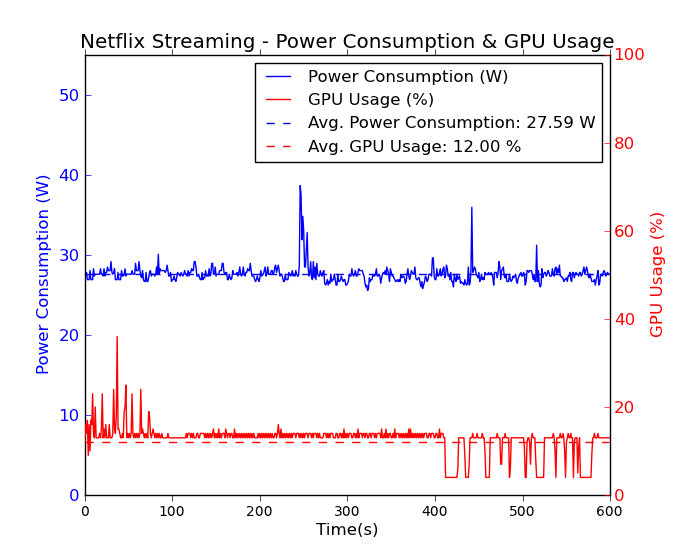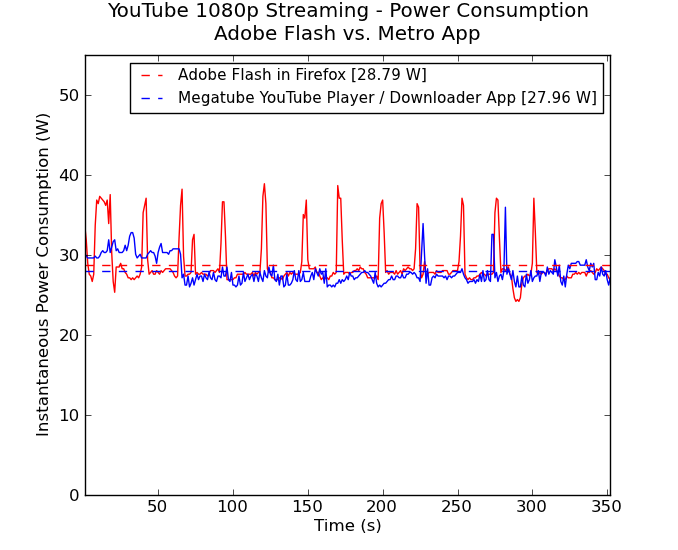Intel's Haswell - An HTPC Perspective: Media Playback, 4K and QuickSync Evaluated
by Ganesh T S on June 2, 2013 8:15 PM ESTNetwork Streaming Performance - Netflix and YouTube
The move from Windows 7 to Windows 8 as our platform of choice for HTPCs has made Silverlight unnecessary. The Netflix app on Windows 8 supports high definition streams (up to a bit rate of 3.85 Mbps for all ISPs, more if the ISP is Super HD enabled) as well as 5.1-channel Dolby Digital Plus audio on selected titles.
It is not immediately evident whether GPU acceleration is available or not from the OSD messages. However, GPU-Z reported an average GPU utilization of 12% throughout the time that the Netflix app was playing back video. The average power consumption is around 28 W.

Unlike Silverlight, Adobe Flash continues to maintain some relevance right now. YouTube continues to use Adobe Flash to serve FLV (at SD resolutions) and MP4 (at both SD and HD resolutions) streams. YouTube's debug OSD indicates whether hardware acceleration is being used or not.
Windows 8 has plenty of YouTube apps. We chose the Megatube YouTube Player / Downloader which allows for stream selection. For our power measurement experiments, we chose the 1080p MP4 stream.
However, we can't be sure whether hardware acceleration is being used with the app, as there is no debug OSD. However, a look at the power consumption numbers reveal that both approaches consume less than 30 W on an average. The difference in the caching of the stream is also visible in this graph, with the Flash approach preferring to download data in bursts while the app prefers to download the whole stream as quickly as possible. Streaming was done over Wi-Fi.

Comparing these numbers with what was obtained using the i3-3225 in a passive build shows that the Haswell build manages to be more efficient even when active cooling (with one big Antec Skeleton chassis fan and a CPU fan) is employed.
On the image quality front, Haswell doesn't seem to change anything here vs. Ivy Bridge. Performance was acceptable before, and it continues to be so here. The big difference is really the additional power savings.













95 Comments
View All Comments
StardogChampion - Monday, June 3, 2013 - link
I am wondering about this comment as well. Everything I've read seemed to indicate it would be available in mini-ITX form for building AIOs (so likely thin mini-ITX). Haswell will be a big disappointment without availability of the BGA packages in mini-ITX form.Sivar - Monday, June 3, 2013 - link
Thank you for the article.Note that x264 is a specific software encoder, not a type of video or a thing that can be accelerated ("While full x264 acceleration using QuickSync...")
H.264 is the video standard.
Also note that x264, the CPU-based encoding software, does not need to run in 2-pass mode to get great quality. 2-pass mode is ONLY if you want a specific file size regardless of quality. If you want a specific quality, you use quality mode. --CRF23, for example, returns small (though variable depending on content) file size and good quality.
ganeshts - Monday, June 3, 2013 - link
Sivar,I did specifically want to mention full x264 acceleration using QuickSync -- That is because x264 is the H.264 encoder of choice for many users. The most beneficial addition to the CPU would be the ability to get hardware acceleration when using x264 with ANY set of options. That is simply not going to be possible with QuickSync (or, for that matter, any hardware-based encoder).
Yes, agreed about the mistaken mention of 2-pass for improved quality. I will update it shortly.
Spawne32 - Monday, June 3, 2013 - link
People always fail to realize what key element in every one of these releases, how big the enthusiast market truly is. All of us posting here on this comment section regarding this review are a small fraction of the overall market intel targets, this is part of the reason AMD suffers so tragically with their current lineup. Power consumption and price are the two biggest factors in a regular consumers mind when purchasing a PC, be it laptop or desktop. Performance numbers rarely play a factor. I don't know what AMD is doing over there but I long for a day when AMD can actually challenge intel and drive prices down even further, because these 230-400 dollar starting prices for "mainstream" intel processors proves once again why I refuse to invest in them regardless of performance. The marginal increase in speed in my day to day activities does not warrant the price being paid for something that is obsolete in 1-2 years. AMD's highest priced processor right now is 179.99, its comparable intel counterpart in haswell....349.99, you do the math.bji - Monday, June 3, 2013 - link
Either the increases in speed with each successive generation are great enough to render previous generations obsolete, or the increases in speed with each successive generation are small enough that the previous generation is not rendered obsolete. You can't have it both ways just to try to make Intel look bad, sorry.I don't know what margin Intel is making on these parts - do you? Remember that they are sinking large R & D and transistor budgets into these minor speed increases, and at the same time sinking lots of money into developing the next generation of process technology. If $300 is not worth it to you, don't buy the part; Intel won't be able to sustain their R & D budgets if nobody buys the results.
Deuge - Monday, June 3, 2013 - link
If one of the GT3 or GT3e parts comes out in a refreshed NUC, id love to see a review of it from an HTPC perspective. Very interested to hear if it can handle Lanzcos + AR or Jinc.dbcoopernz - Monday, June 3, 2013 - link
Is the inability to use LAV with DXVA-native for madVR an Intel limitation? The devs of both the LAV filters and madVR have told me (on the doom9 forum) that DXVA-native is fine for madVR on AMD GPU's.BMNify - Monday, June 3, 2013 - link
DXVA native DOES work with AMD using LAV filters and MadVR... I'm using it as I type (watching MotoGP)ganeshts - Monday, June 3, 2013 - link
It also works with the Haswell piece. I will update the article ASAP.BMNify - Monday, June 3, 2013 - link
APU is the go to for HTPC builders. And stop with the power this and thermals that... undervolt it, toss in a Pico PSU, suspend to memory when not in use and enjoy. Take the hundreds saved and buy a Kabini or two as clients.If we're talking balls to the wall processing might, absolutely, lets talk Intel but not for a simple HTPC.